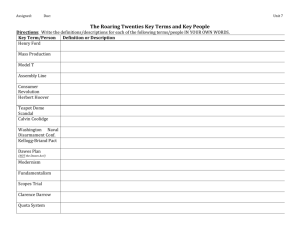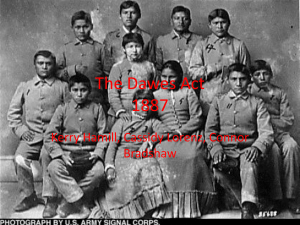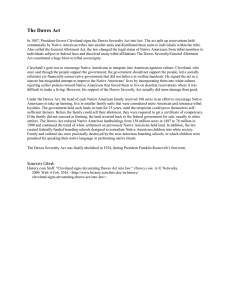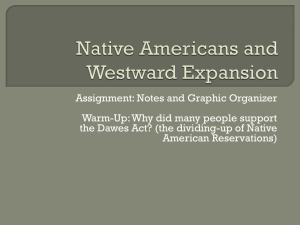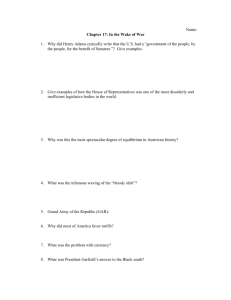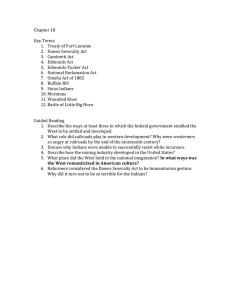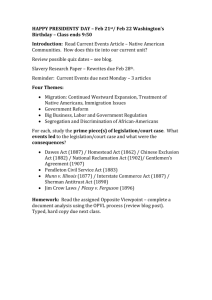Power Point - The Dawes Act of 1887
advertisement
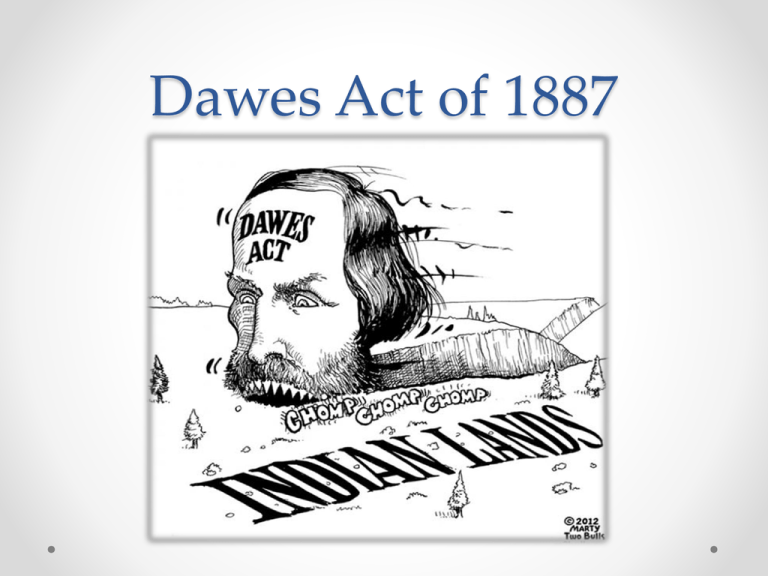
Dawes Act of 1887 Dawes Act of 1887 The Dawes Act of 1887 also referred to as the General Allotment Act or the Dawes Severalty Act, authorized the President of the United States to survey American Indian tribal land and divide it into allotments for individual Native Americans. In order to convince Native Americans to relocate and lay claim to the assigned lands the government offered an incentive, citizenship. In order to earn U.S. citizenship Native Americans would have to accept the allotments and live separately from their tribes tending their property on their own. Important Requirements of the Dawes Act: • A head of family would receive a grant of 160 acres • A single person or orphan over 18 years of age would receive a grant of 80 acres • Individuals under the age of 18 would receive 40 acres each • The allotments would be held in trust by the U.S. Government for 25 years • Eligible Native Americans had four years to select their land afterwards the selection would be made for them by the Secretary of the Interior Video: The Dawes Act of 1887 • While watching the video below consider the shifting reality faced by the Native American people of 1887, and whether or not the information presented depicts history as we study it today. • Also consider the different interpretations of reality from the view points of the Native Americans, and the United States government officials. • What does the rhetoric of the video express? • Consider that rhetoric leads to many different interpretations of reality that affect our view regarding the world around us (Borchers). • How are the views/realities of those affected by the Dawes Act different/same? http://www.youtube.com/watch?v=45HATCWo2PQ Purpose • The purpose of the Dawes Act was supposedly intended to protect Native American property rights and welfare during the coming land rush that was anticipated when Indian lands would be opened to settlers. However, the purpose of the Dawes Act was also an attempt to integrate Native American Indians into white society by changing their lifestyle to the "civilized" western lifestyle of farmers and settlers. Congressman Henry Dawes who authored the act stated his belief that assigning property rights to Native Americans would urge the "civilizing process" stating that to be civilized meant to "wear civilized clothes...cultivate the ground, live in houses, ride in Studebaker wagons, send children to school, drink whiskey [and] own property". Changes to Native American Culture: • To break up tribes • To halt the nomadic lifestyle of Native Americans • To integrate Native Americans into the lifestyle and culture of western Americans • To enroll with the Bureau of Indian Affairs - later called the 'Dawes Rolls' • To encourage Native Indians to adopt a settled farming based existence • To reduce the cost of the administration of Native Americans • To settle and allot individual Native Americans plots of land • To open the remainder of the "surplus" land to white settlers for profit 1880's Native American Imagery Before and After Photo of Boy Indian Student White Teachers and Native American Students Native American Family Native American Group of Women and Children Dawes Act and Oklahoma The passing of the Dawes Act in 1887 opened the way for the sale of Native American lands prompting white settlement in Indian territory. The now unassigned lands were considered the best public land in the United states. The passing of the Indian Appropriations Bill of 1889 allowed for the two million acres to be opened for settlement. The land cleared by the passing of the Dawes Act was about to host the first Oklahoma Land Rush. The Oklahoma Land Rush An astounding 50,000 white settlers flooded the plains to stake their claim of the available two million acres of Native American lands now open for settlement. Video: Land Run OK Moments While watching the video below consider how the rhetoric used influences our perception of this part of Oklahoma's history. According to Gerard Hauser, "A sense of history provides continuity of customs and traditions, of law, and of accomplishments..." (Hauser 190). How does the rhetoric of this video shape our view of the Oklahoma Land Rush? Was the settling of Oklahoma after the passing of the Dawes Act an accomplishment? Why or Why not? https://www.youtube.com/watch?v=l3qpVkZkGes Assignments • CONTENT SKILLS o Content Standard 1: The student will analyze the transformation of the United States through its civil rights struggles, immigrant experiences, settlement of the American West, and the industrialization of American society in the PostReconstruction through the Progressive Eras, 1865 to 1900. Questions 1: Examine the rationale behind federal policies toward Native Americans including the establishment of reservations, attempts at assimilation, and the impact of the Dawes Act on tribal sovereignty and land ownership. Content Standard 2: The student will evaluate the major political and economic events that transformed the land and its people prior to statehood. Questions 2: Compare and contrast multiple points of view to evaluate the impact of the Dawes Act which resulted in the loss of tribal communal lands and the redistribution of lands by various means including land runs as typified by the Unassigned Lands and tribal allotments. Useful Links • National Archives: Maps of Indian Territory, the Dawes Act, and Will Rogers' Enrollment Case File • History: Cleveland signs devastating Dawes Act into law • PBS: Arc • History: The Oklahoma Land Rush Begins • Oklahoma Historical Society: Oklahoma Land Run References • Alchin, Linda. "Dawes Act." Siteseen Ltd. Mar. 2013. Web. 08 May 2015. Borchers, Timothy. Rhetorical Theory: An Introduction. Long Grove: Waveland Press, 2006. Print. Fitzham, John. "The Dawes Act of 1887." Youtube. Youtube, 23 Jan. 2011. Web. 08 May 2015. Hauser, Gerard A. Introduction to Rhetorical Theory. 2nd Ed. Long Grove: Waveland Press, 2002. Print. History: The Oklahoma Land Rush Begins. A&E Networks. Web. 08 May 2015. Oklahoma Council Social Studies, prod. "Land Run 1889 OK Moments." Youtube. Youtube, 20 Sept. 2013. Web. 08 May 2015. Oklahoma Historical Society, prod. "The Oklahoma Land Run." Web. 08 May 2015. PBS, prod. "New Perspectives on the West: The Dawes Act of 1887." THE WEST FILM PROJECT and WETA. 2001. Web. 08 May 2015. United States. Dept. of Education. "Oklahoma Academic Standards." Social Studies. US Dept. of Education. n.d. Web. 08 May 2015.
